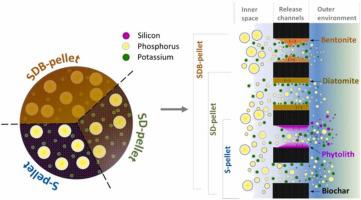Journal of Environmental Chemical Engineering ( IF 7.4 ) Pub Date : 2022-01-19 , DOI: 10.1016/j.jece.2022.107237 Van M. Dinh 1, 2 , Hue T. Nguyen 1, 3 , Anh M. Nguyen 1 , Thuy T. Nguyen 1 , Thanh-Lan Nguyen 4 , Daniel Uteau 5 , Nam H. Nguyen 6 , Tien M. Tran 7 , Stefan Dultz 8 , Minh N. Nguyen 1

|
Recycling of straw in novel forms, e.g., slow release mediums, has increasingly gained attention. This study aimed to use rice straw for pellet fabrication and demonstrate the ability of pellets for slow delivery of phosphorus (P) and potassium (K). To increase the cohesiveness of the medium and to modify release properties, additions of diatomite and its mixture with bentonite were also tested. We fabricated three types of biochar pellets from different mixtures, i.e., ‘straw and NaH2PO4’ (9:1); ‘straw, NaH2PO4 and diatomite’ (8:1:1) and ‘straw, NaH2PO4, diatomite and bentonite’ (8:1:0.5:0.5) that were correspondingly named as S-pellet, SD-pellet and SDB-pellet. The kinetic experiments have revealed the performance of the pellets in delaying P and K releases. In the first 2 weeks, P and K concentrations released from S-pellet, SD-pellet and SDB-pellet were exponentially increased up to 156 and 163, 107 and 77, 113 and 75 mg L−1, respectively. The released P amounts at this stage were equal to 83.9%, 74.7% and 79.9% of the total P contents while those of K were equal to 81.7%, 53.6% and 52.3% of the total K contents in S-pellet, SD-pellet and SDB-pellet, respectively. All the major constituents in the pellets (phytolith, diatomite, bentonite) revealed their mutual interdependencies in regulating the overall release rates of P and K. The effective performance of the pellets could be an indication for a simple method to create slow-release fertilizers that can eventually bring more incentives to farmers to change their way to handle straw towards more high-tech or sustainable practices.
中文翻译:

颗粒化稻草生物炭作为缓释输送介质:磷和钾的储存和供应的潜在途径
以新型形式(例如缓释介质)回收秸秆越来越受到关注。本研究旨在使用稻草制造颗粒,并证明颗粒具有缓慢输送磷 (P) 和钾 (K) 的能力。为了增加介质的内聚性并改变释放性能,还测试了添加硅藻土及其与膨润土的混合物。我们用不同的混合物制造了三种类型的生物炭颗粒,即“秸秆和 NaH 2 PO 4 ”(9:1);'稻草,NaH 2 PO 4和硅藻土' (8:1:1) 和'稻草,NaH 2 PO 4、硅藻土和膨润土'(8:1:0.5:0.5),分别命名为S-pellet、SD-pellet和SDB-pellet。动力学实验揭示了颗粒在延迟 P 和 K 释放方面的性能。在前 2 周,从 S-pellet、SD-pellet 和 SDB-pellet 释放的 P 和 K 浓度呈指数增长,分别达到 156 和 163、107 和 77、113 和 75 mg L -1, 分别。该阶段释放的P量分别占总P量的83.9%、74.7%和79.9%,而K的释放量分别占S-pellet、SD-中总K量的81.7%、53.6%和52.3%。颗粒和 SDB 颗粒,分别。颗粒中的所有主要成分(植硅体、硅藻土、膨润土)在调节 P 和 K 的总体释放率方面显示出它们相互依存的关系。颗粒的有效性能可能表明一种简单的方法来制造缓释肥料最终可以为农民带来更多动力,改变他们处理稻草的方式,转向更多高科技或可持续的做法。











































 京公网安备 11010802027423号
京公网安备 11010802027423号